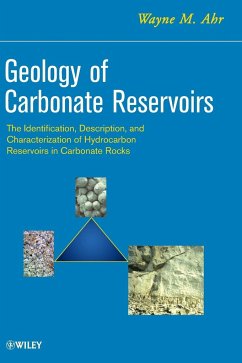A new way of characterizing hydrocarbon reservoirs in carbonate rocks that facilitates their exploration and development
This timely reference presents the information scientists need to explore and develop carbonate reservoirs in the most efficient and profitable ways. Carbonate rocks contain at least half of the world's oil and gas and much of its groundwater. Primary extraction of oil recovers about one-third of it; two-thirds waits for specialized recovery methods that depend on precise knowledge of reservoir geology. Covering everything from the basics to more sophisticated ways of assessing reservoirs, Geology of Carbonate Reservoirs:
_ Explains how and where carbonate rocks form and how they do, or do not, become reservoirs
_ Discusses reservoir properties-the interaction between rocks and fluids-and how rock properties influence saturation, wettability, capillarity, capillary pressure, and reservoir quality
_ Covers depositional carbonate reservoirs,diagenetic carbonate reservoirs, and fractured reservoirs
_ Offers a new genetic classification of carbonate porosity that helps scientists predict spatial distribution of porosity and permeability; it's a practical way of characterizing hydrocarbon reservoirs in carbonate rocks
_ Helps scientists recognize, analyze, and map reservoirs and make more accurate volumetric calculations and economic forecasts
This book's goal is to help scientists explore and develop the vast resources in carbonate reservoirs more efficiently and economically. Though the book is written for petroleum geologists, geophysicists, and engineers and students in those fields, this is also a good reference for hydrogeologists and environmental geologists because reservoirs and aquifers differ only in the fluids they contain.
Hinweis: Dieser Artikel kann nur an eine deutsche Lieferadresse ausgeliefert werden.
This timely reference presents the information scientists need to explore and develop carbonate reservoirs in the most efficient and profitable ways. Carbonate rocks contain at least half of the world's oil and gas and much of its groundwater. Primary extraction of oil recovers about one-third of it; two-thirds waits for specialized recovery methods that depend on precise knowledge of reservoir geology. Covering everything from the basics to more sophisticated ways of assessing reservoirs, Geology of Carbonate Reservoirs:
_ Explains how and where carbonate rocks form and how they do, or do not, become reservoirs
_ Discusses reservoir properties-the interaction between rocks and fluids-and how rock properties influence saturation, wettability, capillarity, capillary pressure, and reservoir quality
_ Covers depositional carbonate reservoirs,diagenetic carbonate reservoirs, and fractured reservoirs
_ Offers a new genetic classification of carbonate porosity that helps scientists predict spatial distribution of porosity and permeability; it's a practical way of characterizing hydrocarbon reservoirs in carbonate rocks
_ Helps scientists recognize, analyze, and map reservoirs and make more accurate volumetric calculations and economic forecasts
This book's goal is to help scientists explore and develop the vast resources in carbonate reservoirs more efficiently and economically. Though the book is written for petroleum geologists, geophysicists, and engineers and students in those fields, this is also a good reference for hydrogeologists and environmental geologists because reservoirs and aquifers differ only in the fluids they contain.
Hinweis: Dieser Artikel kann nur an eine deutsche Lieferadresse ausgeliefert werden.








